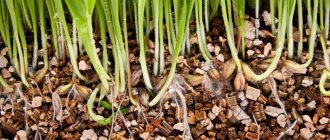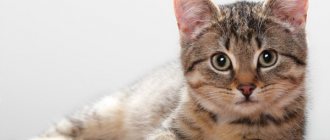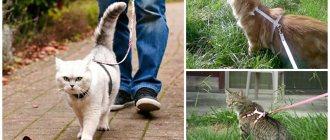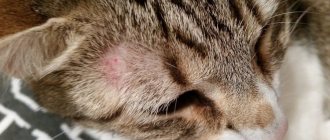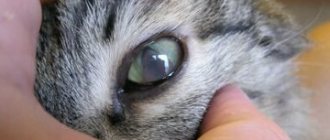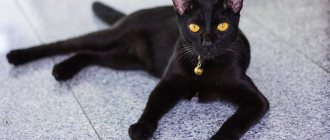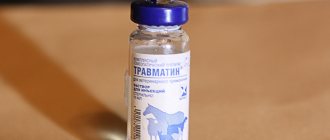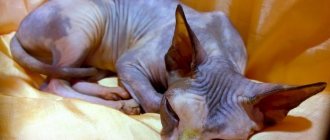Green, juicy grass for cats is a complete, affordable food in a pet’s diet. Young shoots contain the vitamins, minerals and fiber necessary for your pet. Planting grass is not difficult: in summer - on a summer cottage, in winter - on a windowsill. Having at your disposal the usual seeds of any cereal and a suitable container, you can provide your cat with fresh herbs, even without sowing them in the ground, at any time of the year.
Self-grown grass is a good alternative to indoor and garden flowers, most of which are dangerous to your pet’s health.
Benefits and harms
The beneficial substances contained in the herb have a beneficial effect on the health of the pet, namely:
Normal hematopoiesis in an animal occurs thanks to chlorophyll.
- Fiber improves digestion and cleanses the stomach of undigested food particles through the gag reflex.
- Vitamins and microelements strengthen the pet's immunity.
- Chlorophyll has a positive effect on the brain, supplies the body with oxygen, and participates in the process of hematopoiesis.
For improved intestinal function, including loosening stools, veterinarians recommend giving your pet sprouted seeds, and narrow blades of grass for strengthening. Grass can cause harm to your pet if the cat has eaten greens treated with herbicides. Domestic cats that are not outdoors and deprived of the opportunity to eat grass can encroach on potted indoor plants, most of which contain toxins that are dangerous to the animal.
What greens do cats eat?
Walking outside in the summer, our furry friends do not nibble all the plants in a row, but only those with thin and narrow leaves. Pets' favorite green food is wild grasses. They form turf using creeping or fibrous roots and cover the ground with a continuous carpet . They are distributed throughout the country and number hundreds of species.
These include:
- wheatgrass;
- sedge;
- wild oats;
- bentgrass;
- bluegrass;
- timothy grass
As soon as the sun warms up in the spring and the soil dries out a little, the shoots of these herbs immediately begin to grow. Leaf blades 0.3–0.8 cm thick appear in May, and flowering panicles appear in July. The seeds ripen in early September and are small grains in a dry shell.
Long-term observations of domestic cats allow us to put forward different versions explaining the reason for eating grass. The fact is that animals do not always swallow green stems. They tear off the top of the leaf, chew it thoroughly and then spit it out. Plant juice contains vitamins and other beneficial substances. But cats are unlikely to know about this. Perhaps they just like the sweet taste of young shoots or want a variety of foods. But it is immediately noticeable that the animal’s mood improves. Another explanation suggests that the habit of eating grass has been preserved in domestic pets since the time of their wild ancestors. In this way, they clear the digestive tract of eaten bones and hairballs, causing vomiting. The edges of the leaf blades are sharp and have veins that catch fur particles and irritate the walls of the stomach. But eating greens does not always end in regurgitation. It also happens that this does not happen, and the hair is removed along with the feces. It has long been noted that cats themselves are able to regulate their intestinal function by biting the upper parts of turf grasses. The eaten plants are not digested and are excreted naturally. There is an opinion among veterinarians that fresh grass has a laxative and even anthelmintic effect. However, no effect on the functions of the abdominal organs is observed. Whether the theory is true remains to be seen.
Wheatgrass, growing in cities, is polluted by car exhaust and helminth eggs.
Can you grow it at home?
To grow your own grass, you need cereal seeds, a suitable container and soil. There is a way to grow grass at home without soil. You can buy different types of grass seeds for cats at a pet store or regular grain at the farmer's market. 2-3 glasses of cereal grains are enough to provide your pet with vitamin greens for the whole season. Lush grass grows quickly under greenhouse conditions, but you need to ensure that the greens do not dry out ahead of time by moistening and spraying the soil. It is good to sow the seeds in several containers at once with an interval of 3-4 days, so that while the cat eats the first harvest, new shoots will grow in the second tray. If it is impossible to grow grass at home, you can buy ready-made greens without chemical additives, the name of which is “Grass for Cats” from the Titbit brand. There are step-by-step instructions for the fortified food. The disadvantage is the high price.
How to grow cat grass at home
A good cat owner who is not indifferent to the animal, if he notices that the pet has begun to eat house plants, will definitely take care of fresh special grass. There are no difficulties with growing plants; you just need to buy seeds and, if necessary, soil. You can immediately purchase a ready-made set, for example, with the name “Alpine Meadows”. Sprouted grass for cats is especially necessary in winter.
Often, owners choose sprouted oats as food for their affectionate pets. It can quickly produce green, juicy grass, but growth requires a greenhouse effect. You can sprout oats at home. It is better to sow the seed in several boxes at once: while the cat eats the first seed, shoots will grow in the second bowl, and shoots will begin to hatch under the lid in the third.
How to choose seeds
Many stores offer grass seeds for cats. You can buy seed on online resources - it’s even more convenient, because the photo clearly shows what the grass is. It is better not to purchase seeds in the markets, especially at low prices, because there is a possibility of purchasing low-quality products or grains treated with dangerous chemicals.
What grass do cats like?
It is generally accepted that cats' favorite plants are valerian and mint. The effect of valerian on cats is usually stimulating, although in some animals valerian, on the contrary, can induce sound sleep. Mint has a calming effect on pets. In such herbs, animals only like the smell; they eat completely different plants. As a rule, cats eat cereals: wheat, green oats, barley, rye. These seeds can be bought at pet stores and grown independently in the countryside. You can also purchase ready-made grass from Grass and Titbit and include it in your cat’s diet.
What grass do cats not like?
If valerian is a favorite plant for cats, then wormwood and onions repel animals. In addition, cats do not like citrus scents, especially lemon. Therefore, if you need to discourage your pet from something, you can place lemon peel nearby. Cats also do not like rue; all felines do not like the aromatic oil and twigs of this plant.
- Homemade cream for sour cream cake. Sour cream recipes with photos
- Shrimp in batter - recipes with photos. How to prepare shrimp batter and fry in a frying pan or deep-fry
- Beer snacks: homemade recipes
How to plant grass
There are many options for growing plants for cats. If you plan to grow seeds in regular soil, then you need to fill a special container with soil in advance, leaving some space at the top. Then pour out the seed evenly and place a thin layer of soil on it. Before planting, it is best to properly wash the seeds and soak them in water for an hour.
When choosing vermiculite as a growing medium, it should be filled with water along with the seeds for about 40 minutes. After draining the liquid, pour the seeds and base into the prepared germination bowl. You can plant grass for your cat on gauze. To do this, the seeds need to be soaked in cold water (1 hour), after which the liquid is drained, gauze is placed on the bottom of the plate, grains are poured on top and covered with the rest of the cloth.
Without land
The method of growing grass in an artificial environment without soil is called hydroponics. This option for planting plants is very convenient for use at home - the method will protect you from soil scattered around the apartment. To implement it, you will need:
- plastic plates - 2 pcs.;
- any seeds;
- gauze;
- cotton wool;
- plastic bag;
- water.
Landing:
- Small holes are made in one of the plates so that excess moisture can drain out.
- The holey plate is placed inside the whole one, and a layer of cotton wool is placed on the bottom.
- Pour water over everything, add grain and cover with gauze.
- Water again and cover the plates with a plastic bag.
- After the grain has sprouted, you need to remove the bag.
Into the soil layer
To germinate grass at home, you need to prepare:
- seeds;
- soil (preferably vermiculite, a mineral that looks like yellow plates);
- a container where the grass will grow (pot, deep plate);
- film.
Landing:
- Before planting, grass seeds should be washed and soaked in water for an hour.
- Pour the soil into a container, leave space on top for the seeds and distribute them evenly on the soil base.
- Add another layer of soil and water.
- Stretch cling film or plastic bag tightly over the container to create a greenhouse effect.
- The mini-vegetable garden is placed on a radiator or cabinet. For 3 days, forget about the existence of plants. The seeds should germinate on the 3rd day, remove the bag after 4 days.
- On day 6, you can safely offer your pet to chew some delicious grass.
- Grown herbs should not be stored for a long time.
What kind of grass do you need?
Fluffies can eat lemon balm.
Cats can be given plants such as:
- Melissa;
- cat mint;
- thyme;
- valerian;
- oats;
- wheat;
- rye;
- barley.
Valerian, mint, lemon balm, thyme, lemongrass excite your pet or, conversely, calm it down. Such herbs are more attractive to animals due to their smell. Cats prefer to eat cereals. Sprouts of fresh grass in winter are very useful. This is the best vitamin supplement for the animal’s excellent well-being. Outdoor cats eat a grass called sow thistle, known as weed. But it has medicinal properties that have a beneficial effect on the health of the pet. An animal with fur of any color, be it gray, red, black and white, outdoor or indoor, needs fresh greens.
The most favorite herb for furry pets is sprouted oats. The young cereal is rich in folic acid, carotene, potassium, magnesium, silicon, and is therefore recommended by veterinarians for inclusion in the diet of a pregnant cat and a growing kitten.
Why do cats need grass?
Wild cats eat greens regularly, while the diet of domestic cats is limited. This situation needs to be corrected, because grass is really necessary for cats, and here’s why:
- Animals lick their fur daily. As a result, a certain amount of villi enters the stomach. The herb has an irritant effect and helps induce vomiting to prevent hair from accumulating in the body.
- Also, the gag reflex helps the cat if she has eaten something wrong or overeat. With the help of green shoots, your pet will quickly get rid of the remains of undigested food.
- This is how wild cats supplement their diet. Greens contain beneficial B vitamins, particularly folic acid. The animal needs it to grow.
- The plant has a strengthening effect on the intestines.
Another reason is that animals simply like the taste of greens. They can bite grass without swallowing it. Some pets play like this. Houseplants often suffer from such habits. Scolding a cat, especially an adult, in such cases is useless. To shift the focus away from flowers, simply plant some cat grass seeds and make them available.
How to plant?
Growing seeds without soil
During the growing period, seedlings should be covered with gauze.
If you don’t have soil at hand, you can germinate oats for your cat using 2 plastic plates of different sizes and cotton wool. The yield with this method of germination is lower than when sowing seeds in the ground. After your pet eats the greens, they need to be re-sowed. The procedure for planting grains without a substrate is as follows:
- Make holes in a small plate to get rid of excess water.
- Moisten the cotton wool and spread it along the bottom of the holed container.
- Place the smaller plate on top of the larger one.
- Place the grains on moistened cotton wool.
- Cover the sown seeds with gauze.
- Wrap both plates in film and place on the windowsill.
- After seed germination, remove the polyethylene.
- Water the young grass little by little with clean water 1-2 r. in a day.
Method of planting in the ground
If soil was used to germinate grains, then the owner of the fluffy will be able to reap several harvests.
In another way, oat grass is planted using garden soil, substrate or soil for flowers. You can sprout greens in a pot, but to ensure stability, it is better to take a container with a wide base and sides up to 5 cm. Grass for cats grown in the ground is removed more than once. You can plant oats for cats in the ground like this:
- Pre-soak the grains in water for 1 hour.
- Pour soil into the prepared container.
- Moisten the soil base.
- Spread the seeds on a moistened substrate.
- Sprinkle a layer of earth no more than 1-2 cm on top.
- Add water.
- Stretch the film on top to create a greenhouse effect.
- Leave the mini-garden for 3 days at the optimal temperature for germination, 24-25°C, during which time the seeds should germinate.
- Remove the polyethylene after 4 days and place the container on the windowsill.
- After a week, young green shoots can be offered to your beloved pet.
Tips for Growing Cat Treats
Buying sprouted grass in a specialized store is an easier option, but, alas, not the cheapest. Therefore, you can grow grass yourself, at home. It's quite simple, quick and effortless. And caring for her will not be difficult. To grow you will need:
- plant seeds (can be purchased at a specialty store at a very low price);
- container for seedlings (both a flower pot and a deep bowl can be used);
- the soil;
- cellophane film (this is necessary to create a “greenhouse” effect at home).
Both soil from the garden bed and prepared soil from the store are suitable for planting. You can also use vermiculite, a granular soil that is golden ocher in color. To plant seeds in the soil, you need to fill them with water in advance for about an hour and a half. Then soil is poured into the container, seeds are planted and sprinkled with a thin layer of earth. Keep the soil well moistened.
If you plant plants in vermiculite, then it must be mixed with seeds, filled with water and after an hour the swollen mixture is placed in a container.
Pet grass feels great even without soil. It can even be grown in gauze. For this method you will need:
- plastic container;
- a fairly large piece of gauze or cotton fabric;
- cellophane film.
Several drainage holes are made in the plastic container. If this is not done, the seeds will rot. A cloth is laid on the bottom of a plastic dish: gauze in several layers, cotton can be in one. Then lay out the seeds and cover the top with another piece of cloth.
For any growing method, it is recommended to create a greenhouse effect by covering the container with the seeds with a bag or film. Make sure the container is tightly closed, then place it in a warm place. In summer, a window sill in the sun will do. In winter, you can place the seedlings next to the battery.
The timing of seed germination is indicated in the instructions for growing them. Usually shoots appear after two or three days. The film should be removed only on the fourth day. And in about a week, the tailed friend will be able to try the first harvest.
Grass for cats does not require special attention; caring for it is very simple. Once every two days you need to water the “lawn”. The root system is washed with running water.
What herbs should a cat not eat?
After eating ivy, your pet will simply become poisoned.
Indoor flowers are dangerous for cats, most of which contain poisonous juice. Especially harmful are philodendron, dieffenbachia, alocasia, monstera, ficus, azalea, caladium, spurge, croton, oleander, adenium, cyclamen, delphinium, ivy, and chrysanthemum. Garden flowers such as lilies, gladioli, tulips, hyacinths, lilacs, pansies, carnations, snowdrops, and primroses are harmful. If a cat eats indoor plants, he is in danger. Once inside, a small piece of a poisonous plant can seriously harm a pet’s health, for example, cause a burn to the mucous membranes, vomiting, diarrhea, provoke nervous disorders, impair coordination, cause kidney failure, heart problems, lead to loss of vision if toxic juice gets into the eyes, possible cases of death. At the first signs of poisoning, you need to provide first aid to the animal and immediately contact a veterinarian.
To protect your pet from dangerous plants, you should not keep them in the house or prevent the animal from accessing flower pots and vases with bouquets. Citrus peels, which cats really dislike, are suitable for this purpose. It is placed near dangerous plants. Also, cats do not like rue, onions, and wormwood.
Why do cats eat grass?
Supplementing the diet with vitamins
The main reason why cats need grass is to normalize digestion and complement their main food. Store-bought food cannot compensate for the lack of vitamins that cats in the wild seek on their own. Green grass contains a large amount of folic acid, vitamin B9, which increases the amount of oxygen in the blood and promotes the growth of the animal. If your pet goes for a walk outside, you may notice how during the walk he carefully selects sprouted stems of lush grass. What grass do cats eat outside? Tailed animals prefer the weed - wheatgrass.
Normalization of the digestive system
Depending on the needs of its body, a cat is able to normalize and improve intestinal motility by additionally consuming green grass in its usual diet. To consolidate the stool, the cat eats young shoots, and for a laxative effect it looks for grass with wide stems.
Cleansing the intestines of hair
Daily cat hygiene procedures include constant cleaning and straightening of the coat. Over time, the animal's fur accumulates in the digestive tract. Such accumulations require additional and abundant consumption of grass. As a result of “self-medication” with grass, the cat provokes either a laxative effect or regurgitates clumps of hair along with a large amount of eaten greens.
Grass-friend and grass-enemy
Not all plants will benefit your pet - there are also some that can cause harm, including serious poisoning. Therefore, not all greens will be useful for a cat. It’s better not to keep others at home at all to avoid trouble.
Useful plants
Catnip or catnip
- Favorite herb for cats. 3% consists of essential oil, which emits an attractive smell and attracts mustaches. Although the smell is stimulating to them, eating this plant calms cats.
Schisandra
. Sedative and diuretic. Serves as an antibiotic and improves digestion.
Parsley
. Not all cats recognize parsley, but its benefits are enormous. It contains vitamin B, C, A and potassium.
Valerian
. Valerian should not be given to cats without the advice of a veterinarian, as it is addictive.
Melissa
. Acts as a laxative, therefore useful for constipation.
Marigold
. They remove worms and improve the functioning of the gastrointestinal tract. Some cats eat not only marigold grass, but also flowers. Make sure that the animal does not overdo it.
Dangerous plants
Azalea
. Contains an alkaloid that is lethal. Causes swelling of the larynx and convulsions, depresses the nervous system and disrupts the heart rhythm.
Schefflera
. Even one leaf can cause breathing to stop. If it gets into the eyes, it can cause conjunctivitis.
Cyclamen
. If your pet eats the stem of the plant, it will be poisoned. For some reason, some cats still eat this grass, as if they are somehow attracted to it. Be careful: put the flower in a pot or don’t plant it in your apartment at all.
Chrysanthemum
. Less dangerous than previous flowers, but also causes an unpleasant effect: diarrhea, vomiting and malaise.
Caladium
. Caladium juice burns the mucous membrane and leads to chronic kidney dysfunction.
Why does a predator need grass?
Cats are by nature predatory animals. This means that the basis of their diet must certainly be meat. However, the cat is not fed up with mice alone. There are many opinions about why pets chew weed.
One of the most popular statements is that animals replenish their supply of vitamins by eating fresh greens. However, a number of studies have shown that this is not entirely true. If a cat were trying to replenish its supply of a certain vitamin, it would taste every blade of grass in search of the right ingredient. But, after observing the musk, you can see that it chews everything indiscriminately, like a goat.
Also, the myth about missing vitamins was refuted after it turned out that the cat’s body is able to independently produce some vitamins that the animal cannot get by eating regular meat.
Consequently, the reason for eating grass has not so much nutritional properties as it carries the unity of murk with nature. This can be seen by how carefully pets treat their “herbal” pots. If the territory allows, they even try to lie on their “indoor lawn.”
Another reason to chew grass is self-medication. Cats with access to walks often regard the lawn as a pharmacy and self-medicate by eating all kinds of weeds.
Scientists have repeatedly wondered what animals can do with herbs. But every time, studies have shown that grass is eaten by both absolutely healthy animals and pets that feel unwell. Therefore, the cat grazes only because he likes it.
Are herbs always beneficial?
Cats living in nature or on the street usually instinctively choose the right herbs for medicinal or cleansing purposes. Pets do not have this experience, and their instincts are most often somewhat muted. There is a high risk for them to chew grass that is hazardous to their health while walking.
Even a plant that is safe in its composition can cause considerable harm if it grows in a polluted area - on roadsides or near industrial enterprises. In addition, there is no guarantee that this grass is not contaminated with helminth eggs or contaminated by the feces of a sick animal.
Not all outdoor grass is good for your pet.
If the animal does not leave the house and does not receive the necessary greenery in the required quantities, then it may well switch to nibbling indoor plants, some of which may be very poisonous. As a result - various troubles, even death, and specifically the following side effects:
- uncontrollable vomiting;
- digestive disorders;
- pain and cramps;
- renal, heart or pulmonary failure.
Common houseplants can cause serious harm to a cat.
Here are some houseplants to keep out of your cat's reach:
- amaralis;
- asparagus;
- geranium;
- dieffenbachia;
- caladium;
- lily of the valley;
- spurge;
- narcissus;
- oleander;
- ivy;
- spathiphyllum;
- physalis;
- ficus;
- philodendron;
- Cyperus;
- cyclamen.
Offer your pet only safe green treats.
Video: which plants can be dangerous for a cat
Cats crave mint and valerian
The amazing affection of cats of all types and breeds for valerian and catnip has always attracted the attention of people. These completely different plants contain special pheromones, which attract both pets and wild predators. Such cat passion can turn out both to the benefit of animals and to their detriment.
Cat mint
The very name of catnip (or catnip) indicates the special attitude of cats to this inconspicuous perennial grass, which grows everywhere like a weed: in meadows and parks, wastelands and vegetable gardens.
Catnip grows up to a meter in height, has jagged leaves characteristic of all types of mint and modest inflorescences of various shades - white, pink, purple. The peak of flowering occurs in mid-summer - during this period the grass is harvested, if necessary.
Catnip is usually harvested during the flowering period
The organic compound nepetolactone is the main component of the essential oil, which determines the attractiveness of the plant to adult cats. Immature kittens are not interested in this natural pheromone, but sterilized animals react to it differently, but most often in the same way as before the operation. Older animals become indifferent to the delights of catnip.
It is curious that this passionate attachment is genetic in cats and cats and is inherited. That is why there are some adult individuals who do not react at all to the “magical” smell of catnip.
By influencing those areas of the brain that are responsible for the emotional sphere, nepetolactone causes mild, but very pleasant hallucinations for the animal - obviously of an erotic nature. Cats do not develop any addiction, much less dependence on this substance, so catnip can be considered a safe plant for them. But prolonged exposure to nepetolactone in especially emotional people can lead to overexcitation and even disorders of the nervous system.
The effect of this herbal aphrodisiac is short-lived and usually lasts no longer than a quarter of an hour. Then it will take at least forty minutes before the cat becomes receptive to it again.
For most cats, catnip evokes pleasant visions.
Catnip can be used either fresh or dried, or as infusions; Pet stores sell ready-made preparations based on the extract of this herb. The properties of catnip are used for various purposes:
- improve appetite;
- trained to use the tray;
- switch attention from scratching wallpaper and furniture to the scratching post;
- processing new toys.
Interestingly, catnip essential oil is hated by some household pests and unwanted insects:
- rats;
- mice;
- cockroaches;
- mosquitoes
By the way, valerian officinalis and drugs based on it have the same properties.
Video: What a cat is willing to do to get catnip
Valerian
Valerian officinalis is popularly called cat herb - almost all adult cats react violently to this plant. The effects of pungent valerian on cats are similar to the effects of catnip on them - but in this case you need to be more attentive and careful. An overdose of the enzyme actinidin contained in the herb and especially the roots of valerian can lead to undesirable consequences.
Valerian officinalis is a tall herbaceous plant with carved leaves and umbrella-shaped inflorescences.
This beautiful perennial plant reaches a height of one and a half meters. It blooms with spectacular white “umbrellas” almost throughout the warm season. All parts of the plant can be harvested, but its roots contain the highest concentration of active substances.
The plant substance is identical to one of the odorous components of cat urine and acts on adult cats as a powerful aphrodisiac, changing for a short time not only their emotional but also hormonal balance. This can pose a serious danger to the animal and cause the following unpleasant side effects:
- convulsions;
- strong secretion of saliva and foam from the mouth;
- clouding of consciousness;
- difficulty breathing, even stopping;
- stroke.
A cat that has tasted valerian or catnip may behave inappropriately
Actinidin has an exciting effect on cats - they behave as if they are in a state of drug intoxication and get great pleasure from it. But this creates a huge load on the nervous system, and if it is unstable, then you should not abuse valerian under any circumstances - it is definitely not fun.
Don't give valerian to your cat just for fun.
The valerian plant is unlikely to cause harm to your pet, but medications that contain concentrated actinidin can become a source of danger for the cat. There are strict contraindications for the use of alcoholic extracts of valerian:
- increased excitability;
- kidney and liver pathologies;
- periods of pregnancy and lactation.
Valerian is dangerous for a pregnant cat
But valerian in moderate doses is very useful for digestion. The fact is that this herbal medicine also has the property of relaxing smooth muscles, which helps relieve spasms and colic in the gastrointestinal tract. Veterinarians also prescribe valerian preparations in the complex treatment of cardiovascular diseases and thyroid problems. You must strictly adhere to the doctor's recommendations and dosage of medications.
Scientists studying the life of wild cats in nature often use valerian tincture to lure the animals closer.
Some other plants can have an effect similar to valerian and catnip on representatives of the cat family:
- peppermint;
- thyme;
- lemongrass;
- Melissa;
- honeysuckle.
Video: cat eats dried valerian
We grow in the ground
To grow, you will need a pack of seeds, soil and a small container. The usual composition for germinating flowers, such as orchids, is suitable as soil. The soil is best light, not overloaded with fertilizers. Seeds grow well in any soil and even without it, because they do not need special nutrition for flowering and fruiting.
What container should I use for grass? There are no special requirements here either. Any deep plate, flower pot, seedling box, or even a new cat litter box will do. The shoots will grow beautifully through the mesh.
How to grow cat grass, all stages:
- Before planting, seeds are soaked for an hour in warm water. This will speed up their germination.
- The container is filled with soil, but not to the very top.
- The prepared seeds are poured onto the ground.
- They are covered with a thin layer of earth on top.
- Seeds can also be grown in vermiculite. To do this, the substrate is soaked for an hour along with the planting material.
- Seeds planted in the soil are moistened; vermiculite can simply be sprinkled with water.
- Now you need to create a greenhouse effect. The growing pot is covered with transparent cling film. You can use a plastic bag.
- In order for the grass to hatch, it is moved to a warm place, for example, near a radiator.
- After just 2-3 days, the first sprouts of grass will appear above the ground. The greenhouse is removed only after 4-5 days. Moisten the substrate in a timely manner.
- The pet is given a treat to chew on a week after boarding. It is advisable for the cat to eat greens directly from the garden. A torn shoot quickly withers.
- You need to sow the seeds once a week, then the animal will be constantly supplied with a vitamin supplement.
